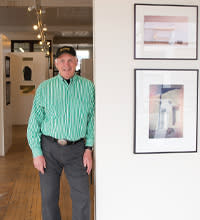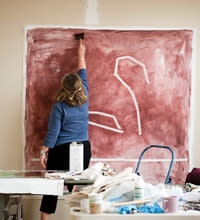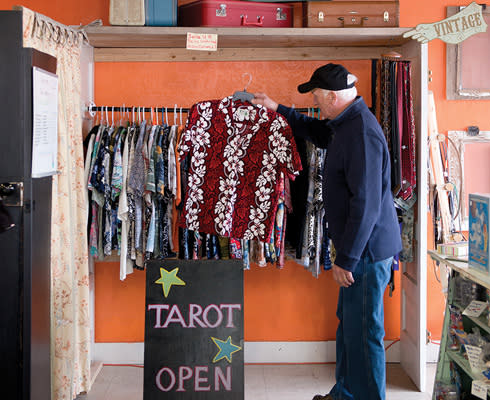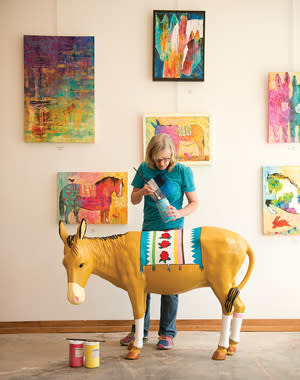NEED TO KNOW
The Carrizozo Artist Tour and Festival will be held the weekend of August 15–16. Open during the festival: galleries and businesses along 12th St., as well as individual artist studios around town. Free. For more information, call Carrizozo Works (575-648-8500) or the Carrizozo Visitor Center at (575) 648-2732.
Carrizozo Visitor Center Caboose Pick up a guide to the burro challenge, officially called the Carrizozo Burro Serenade. Find all 21 of them and bring your guide back to the visitor center for a small prize. Open 10 a.m.–2 p.m., Thurs., Fri., Sat., and by appointment. Corner of Central Ave. and Airport Rd.; (575) 648-2732
Carrizozo Heritage Museum Browse displays about Carrizozo’s past. Open 10 a.m.–2 p.m., Thurs., Fri., and Sat., March–Dec., and by appointment. 103 12th St.; (575) 648-2102
DINING
The Carrizozo Café Choose from a varied menu with sit-down dining. Open Tues.–Sat., 9 a.m.–7. p.m.; Sun., 9 a.m.–2 p.m.; closed Mon. 1108 E Ave.; (575) 430-9708
12th Street Coffee A convenient place to stop for a latte or sandwich while you’re exploring. Open Mon.–Fri., 6:30 a.m.–6 p.m., Sat., 8:30 a.m.–4 p.m., and Sun., 10 a.m.–2 p.m., closed the first Sun. of every month. 410 12th St.; no phone
Roy’s Ice Cream Parlour You can order soda fountain treats like the “Valley of Fires,” made with three scoops of chocolate ice cream, chocolate syrup, cherry syrup, and whipped cream. Open 12–5 p.m., Wed.–Sun. 1200 E Ave.; (575) 686-0787; roysicecreamparlour.com
LODGING
Four Winds Motel was recently renovated. 6539 US 380 W; (575) 648-3260
Rainbow Inn offers rooms in a more retro style. 103 Central Ave.; (575) 648-4006; rainbowinnnm.com
Sitting on a bench on historic 12th Street in Carrizozo, listening as the rumble of a passing Union Pacific freight train underscores the sweet morning crooning of birds, I begin to sense that I’m being watched. Looking up, I find my glance met by two piercing eyes. From a burro. On the roof of an adjacent building. With a Batman logo on his side.
Normally such a vision would be baffling, to say the least, but this burro is all metal and vibrant colors, and he’s one of 21 placed strategically around town, each painted by a local artist. Collectively called the Painted Burros of Southwestern New Mexico, they are just one of the ways that Carrizozo is inviting visitors to pause for longer than it takes for the stoplight at that intersection to change colors.
Something interesting is happening in Carrizozo, a rustic town of just under a thousand residents set at the intersection of US 54 and US 380, about 40 miles northwest of Ruidoso. It has to do with art, and exploration, and renewal in its many forms, and with the participatory spirit that can take hold when a community discovers its own potential. An effort is under way here to revitalize this town, bring in new ideas and new opportunities, grow the population to a self-sustaining level by appealing to potential residents like artists and retirees—and to do it all while preserving the town’s historic character. But more interesting still is what’s behind all this. Or, rather, who: in this case, a diverse set of talented people united by their love of place.
Apickup comes to a stop across the street, and the driver gets out. It’s Warren Malkerson, owner of Malkerson Gallery 408 on 12th Street and one of the biggest boosters of that revitalization. We begin with a driving tour, down 12th Street, past the galleries and homes making up this part of town, past the Four Winds Restaurant, where the waitress is liberal with the chile and the hons. Clouds hang low over the Carrizo Mountains to the east. It might rain, or it might be clear—the day is young still and hasn’t given much thought to its own future. Along the way, Warren tells me of his former life in the corporate world, where he held executive positions around the country with Pillsbury, L.L.Bean, and PepsiCo. In retirement, he and his wife, Joan, decided to focus on her art. After Warren, a Harvard Business School graduate, reviewed the state’s statistical abstract and found the number of sunny days here and the low population to both their liking, they chose to move here.
We pull over at a historic marker north of town, the one detailing Carrizozo’s history as a railroad town in the early part of the 20th century. The prosperity of those formative years gave Carrizozo and its then-2,000 residents a drugstore, theater, Ben Franklin five-and-dime, three auto dealerships, and resplendent Craftsman-style homes built by local architect Frank English—and with all that, enough clout to claim the Lincoln County seat. But the prosperity faded, and in the past few decades, so has the population, a trend Warren and others hope to reverse. They’re doing so by making Carrizozo a place to discover. They’re restoring and repurposing historic properties, creating new amenities, and promoting the affordability, cultural diversity, and quality of life this town offers.
Then they’re inviting people to join in and be part of the change themselves—because the renewal happening here, they believe, takes place at both the community and individual levels.
“This is a place where you can reinvent yourself,” Warren says. “Do something you haven’t done before. Discover something you haven’t discovered before, about yourself, about other people, about life in general.”
Right away, a pattern emerges that will repeat itself throughout my visit. Warren talks about the artists, the businesspeople, the civic-minded folk leading the revitalization of this town, while downplaying his own role. Artists have one another’s paintings on the walls of their homes, their neighbors’ sculptures in their own gardens. Every person I meet touts another whose work has been shown in prominent venues, whose talents have been praised among noted critics, and whom I have to meet before I leave.
“Here, it’s a little gentler,” says Judy Pekelsma. Warren has brought me to see her Heart of the Raven gallery on 12th Street. Judy moved to New Mexico from Illinois and opened her gallery two years ago, inspired by the opportunity she saw here to be part of something new. “I think we’re growing a community of artists that are working together,” she continues, “instead of competing with each other all the time."
It’s paying off. Lured by the collegiality here and by the opportunities that Carrizozo offers to both established and emerging artists, like gallery shows and inexpensive studio space, a number of talented individuals are choosing to make this their home. In the past 10 years, some 20 artists have moved here, bringing talents ranging from painting to sculpting to illustration to movie-making. I decide my first day’s mission will be to explore the breadth of that range.
That mission rightly begins with 12th Street itself.
Deserving a place among the most interesting neighborhoods in New Mexico, 12th Street sits off the main thoroughfare. It’s been ignored by passing traffic and passing fads. From the playful sculpture garden beside Malkerson Gallery 408 to the stoic countenance of the old Carrizozo Gas Company building, which still advertises its phone number as 60, 12th Street is a crash course in Carrizozo. Behind the electric co-op building grow stands of carrizo grass, tall stalks that resemble bamboo, from which the town derived its name. Two blocks away are the railroad tracks, though the depot and roundhouse are gone and passenger service stopped in 1968. At the far north end is the old icehouse, now home to the Carrizozo Heritage Museum.
But it’s the two blocks at the southernmost end of 12th Street that reflect the changes taking place here today. Properties owned by Warren and others are being given new life as galleries, small businesses, and artist studios.
 Impresario Warren Malkerson in his capacious Tularosa Basin Gallery of Photography.
Impresario Warren Malkerson in his capacious Tularosa Basin Gallery of Photography. Joan Malkerson in her studio.
Joan Malkerson in her studio.Most prominent among them is the former Carrizozo Trading Company building, a grand brick edifice constructed in 1917, nine years before Carrizozo even had electricity. A sign painted on the side still advertises highest prices for hides & pelts. Today, pelts have given way to photographs; the building is home to the Tularosa Basin Gallery of Photography. At 7,500 square feet, it’s one of the largest photos-only galleries in the state—and plans include doubling its size by adding the basement’s square footage. Inside, under 14-foot-high ceilings, an impressive collection of photos awaits, all taken by member photographers who live in the state. The photos, all of which have been shot in New Mexico (a gallery requirement), depict landscapes, wildlife, old buildings in even older towns. Some are straightforward; others bend the rules.
Upstairs, Warren shows me spaces that have been converted into artist studios, giant three-room suites with light bouncing in off the Carrizo Mountains. Warren’s wife, Joan has a studio here, where she is working on what will be a 76-page fold-out book of abstract prints inspired by the Codex Borgia, an ancient Mesoamerican manuscript used for divination purposes. She calls hers the Codex Carrizozo.
Across the street from the gallery is a building owned by Julia Danielle and Marc Cohen. The couple rolled into town one day in 2006, stopping to photograph a building, when Warren, who had been sweeping the floors in the photo gallery, went out to greet them. Not above making his “reinvent yourself” pitch to individuals one-on-one, Warren sold them on the town, and they decided to stay.
“This is an oasis of light and creativity,” Marc says of Carrizozo. Given his career history, he would know. Marc is the former assistant to Broadway director Tom O’Horgan, famous for his work on the groundbreaking musicals Hair in 1968 and Jesus Christ Superstar in 1971. Julia, a singer and dancer, appeared on Broadway in 1600 Pennsylvania Avenue and Sweet Charity and in movies like Spike Lee’s School Daze and Francis Ford Coppola’s The Cotton Club.
Julia and Marc have painted one room in their building Chroma-Key green to serve as a special-effects backdrop for their video art, created as part of an enterprise they call Dream Space. Julia has already directed their first short film, “Legend of Four,” a western featuring local teenagers and shot in Carrizozo and nearby White Oaks. At his Play with the Box storefront gallery (in the same building), Marc displays his small, framed boxes containing figurines in layered, three-dimensional tableaux. This box art once trended in New York as, of all things, a fashion accessory, with people pinning the tableaux to their shirts.
Also on this block is the Shire of Ghillie Dhu, where retired educator Jamie Gieb lays her hands on colorful pieces of fabric, lets them tell her what shape they want to take, and then fashions them into girls’ dresses. One gallery is run by Caren Goodrich, whose paintings of donkeys and flowers in bright colors dance across her canvases. Malkerson Gallery 408 has hosted two shows a year since opening in 2005, each featuring local artists.
Afternoon surrenders to evening, and I make my way to a local potluck. I meet several local artists and community leaders, each of whom points out another person in the crowd and tells me I can’t leave until I speak with them, too.
Mike Lagg reaches through the assembly to offer me a tray of sausages. I’m intrigued by the funky wooden toothpicks stuck in them, which Mike made himself. Shaped like dancing figures, they are an example of Mike’s special talent: He makes the practical beautiful, and the beautiful practical. In his workshop and studio, invention and fancy collide to create lamps that bend in multiple directions at once, wooden skeletons with wire for brains, and doorbells that “ring” by moving pieces of an oceanic panorama. Mike and his partner, Paula Wilson, also host a monthly gathering of artists they call MoMAZoZo, an amalgam of the acronym of the Museum of Modern Art and the town name. But here MoMA also stands for the Museum of Mobile Art, Mike’s community art projects. Those happen on 12th Street and include everything from tumbleweed racing to “Giant Jenga,” a life-size version of the tabletop game, played with three-foot-long wooden slabs. You know you’re in a town full of artists when the jumble of boards falls to the ground and the players all comment on how beautiful it looks.
Jim Boswell, director of the Carrizozo Chamber of Commerce, is my host the next morning. He has a name for what’s happening here: an “irrepressible renaissance.” And that renaissance has a purpose, as he explains to me. By investing in itself, Carrizozo hopes to grow its population to at least 1,500—enough to maintain a tax base that will support the infrastructure, educational system, and economy of a healthy town. To help reach that goal, the chamber, with the local economic development office, Carrizozo Works Inc., has partnered with the state and the New Mexico MainStreet program. Carrizozo has been designated as a “Frontier Community” under a new program sponsored by the New Mexico Economic Development Department, qualifying it to receive assistance from the state in identifying funding sources for projects within the community, like reviving older structures. They’re trying, for example, to save one of the last New Mexico adobe theaters, now sitting empty on 12th Street. They’re also helping grow new economies, like the art sector, along with service industries to support them. And they’re promoting the town with street fairs and other community events, like the Carrizozo Artist Tour and Festival, scheduled for the weekend of August 15 and 16. The festival marks the first time the artists of Carrizozo present themselves as a group.
Jim takes me to visit Diane Dean and the newly formed Friends of the Library, who are all busily sorting through boxes of books so numerous they fill shelves in multiple rooms. The old Carrizozo Recreation Center, built in the 1960s but closed since 2000, is slated to reopen as the site of a new library—and, if all goes well, a renovated eight-lane bowling alley. (Soundproof glass will separate the two.) Townspeople and visitors have donated hundreds of books to form the basis of the collection. The project is in competent hands, as a greater lover of literature than Diane would be hard to find. Across the door of her guest bathroom, she has penciled quotes she admires, from people like Proust, Gertrude Stein, and even actor Johnny Depp. One from Mark Twain seems particularly apt for this project: “There is apparently nothing that cannot happen.”
Jim and I also visit the Carrizozo Public School, which houses elementary through high school classes, where we’re met by local artist Dennis Dunham. It’s here, in the courtyard of the school, where one of the most heartwarming symbols of this new era in Carrizozo history can be found. Dennis, along with Judy, from the Heart of the Raven gallery, helped elementary and middle school students fire the tiles for the face of a human-powered sundial. Dennis shows me how it works by standing on the month tile and raising his hand, casting a shadow across the correct time tile. Through such collaborative efforts as this, a vital link between the new economy and the next generation of Carrizozo residents is already taking shape.
 Highway 54 Emporium offers a surprising stash of kicky Hawaiian shirts and mystical insights.
Highway 54 Emporium offers a surprising stash of kicky Hawaiian shirts and mystical insights.
Later, I drop in at the Highway 54 Emporium for a tarot reading with Virginia Braden, whom I met the night before at the potluck. The Emporium is an old-time general store owned by Sheila and Bob Lynch, chock-full of Hawaiian shirts, rare Cracker Jack prizes, board games, Face Jugs, kites, and even legitimate wooden nickels.
Virginia and I step into an alcove behind a curtain. As soft classical music plays in the background, she lays out the spread and offers an interpretation. I am to expect a transformation, the cards reveal, and I should see in it a chance to start anew, to change how I see myself and how the world sees me.
If Carrizozo itself had a fortune, I expect it would be the same.
On my last day in town, I make a quick stop at 12th Street Coffee to settle the tab I’ve been running since I got here. Owned by Shelby Hyatt, an Army veteran with tours in Afghanistan and Iraq, the shop has become a place where people come for good coffee and good company. Like the man everyone here calls Sully, a former Marine who now builds custom Victorian dollhouses. Outside, a young tourist couple poses in the street for a photo. They have friends named Carrie and Zoe, it turns out, so they’re here taking pictures of every sign in town.
My time is winding down, but before I leave, there’s one more thing I must do. Actually, 20 more things.
 Caren Goodrich is in on Carrizozo’s Painted Burros of Southwestern New Mexico project.
Caren Goodrich is in on Carrizozo’s Painted Burros of Southwestern New Mexico project.Those burros. Carrizozo’s new “Burro Tour Challenge” invites visitors to find all 21 of them.
I start with “Blue Sky.” He’s outside the Carrizozo Visitor Center, housed in an old caboose—volunteers who man the center are called “conductors.” They include Gwendolyn Watson, a classically trained cellist who used to teach at the San Francisco Conservatory of Music. She moved here in 2013, seeing in the renewal of this town a place where she, too, could “grow and rearrange.”
The burro called “Yellow Bird” is at the Carrizozo Town Hall, and “Haulin’ Ass” is at the Carrizozo Bike Shop, run by Shelby’s husband, Rick. The couple met in the Army and moved here after leaving the service. Rick can fix motorcycles, cars, trucks, and chain saws. Rick told Warren Malkerson he’d place a burro at his business only if it had leather and handlebars. An hour or so later, Warren arrived with a burro fitted with handlebars and boots. Nobody is quite sure how he did that.
And, at last, back on 12th Street, where I started, I nod to my old inquisitive friend, the “Batman” burro. He’s been up there, high atop the Heart of the Raven gallery, watching me this whole time. A light inside him turns on in the evenings to brighten the night. He’s like a beacon. For that reason, I decide he’s my favorite.
Waving goodbye to Shelby at 12th Street Coffee on the way to my car, I recall a moment from my first day in town. Two teenage girls had stopped into the shop for an after-school treat. They took seats near the window over-looking the studios and galleries. There, they chatted about matters of great importance and giggled in the pleasure of each other’s company. Those two girls didn’t have to come to 12th Street. They wanted to.
The renewal taking place in Carrizozo—that “irrepressible renaissance” happening here—is ultimately about the future. A future in which Carrizozo is a destination not just for people from other places, but also for those who grew up here. Not just a town where you can reinvent yourself, but also one where you can invent yourself in the first place.
From the looks of things, that future will be here shortly, just as soon as it finishes its homework.
David Pike is writing a series of articles on small-town New Mexico.

